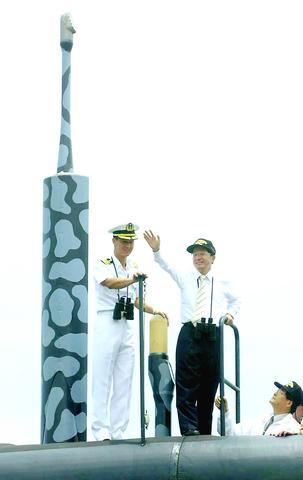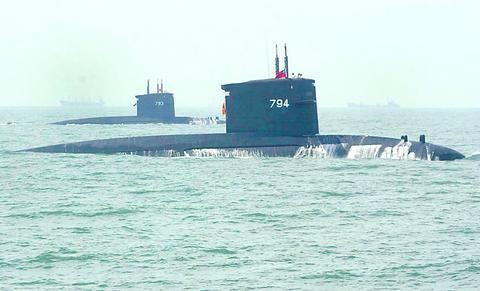More than 100 reporters accompanied President Chen Shui-bian (
"Submarines are the most ideal weapons we can use during a combat situation in the Taiwan Strait. They are also a basic weapon for an island nation such as Taiwan to use to defend itself," Chen said.
Chen made his remarks at the navy's Mercury Port inside Tsoying's largest naval base, in Kaohsiung. The Mercury Port is an exclusive port for the country's four submarines, which include two US-made Guppy-class vessels and two Dutch-made Zwaardvis-class vessels.

CHIANG YING-YING, TAIPEI TIMES.
It was the president's second time aboard a submarine since he took office in 2000, but it was the first time that he led a group of reporters through a submarine joint military exercise.
Chen hopped in the SS-794 Sea Tiger while reporters were divided into two groups to go aboard the Lafayette-class frigate PFG-1207, the Wu Chang, and the SS-793 Sea Dragon, which also had Presidential Office Secretary-General Su Tseng-chang (
According to Captain Chou Yih-chun (周益群), the commanding officer of the SS-793, yesterday's exercise was participated in by two submarines, three frigates, one S-70C helicopter and one S-2T Turbo Tracker aircraft. During the exercise, the two submarines were opposed to the three frigates and two aircraft.

PHOTO: CHIANG YING-YING, TAIPEI TIMES
According to the MND, the two submarines successfully destroyed the frigates using torpedoes in the simulated battle, and the entire action was processed on a computerized simulated program.
The distance between the SS-793 and SS-794, which were the focus of yesterday's exercise, was approximately 300m. Both submarines cruised at the speed of 18 knots and dived to reach a depth of 17.5m at a location which was approximately 8.8km away from Tsoying base.
Chou said that the Zwaardvis-class submarines are capable of diving to a depth of 240m.
In addition to the simulated naval battle, the two submarines also carried out an "emergency surface" to end the entire exercise.
During the exercise, the president suffered from minor sea sickness, but he still took the helm of the SS-794 and acted like a sailor for a few minutes.
The entire exercise lasted approximately two hours.
Due to concerns involving the safety of the president and the reporters, the navy canceled several items during yesterday's exercise. However, some politicians complained that the president was wasting public funds and leaking crucial military secrets by what he did yesterday.
In addition, crtics said, a small-scale military exercise like yesterday's would not help sailors in a real combat situation.
"There might be concerns that classified military information might be leaked," said Democratic Progressive Party Lawmaker Kuo Jung-tsung (
The navy also invited several female petty officers to board the submarines and frigates and participate in yesterday's exercise. However, it is still not permitted for female personnel to serve on a submarine.
"We do not have enough room inside a sub [for additional facilities for women] and may not be able to provide them with adequate privacy, either," said Wu Shang-fu (吳商福), a senior first class petty officer onboard the SS-793.
Also see story:

The US government has signed defense cooperation agreements with Japan and the Philippines to boost the deterrence capabilities of countries in the first island chain, a report by the National Security Bureau (NSB) showed. The main countries on the first island chain include the two nations and Taiwan. The bureau is to present the report at a meeting of the legislature’s Foreign Affairs and National Defense Committee tomorrow. The US military has deployed Typhon missile systems to Japan’s Yamaguchi Prefecture and Zambales province in the Philippines during their joint military exercises. It has also installed NMESIS anti-ship systems in Japan’s Okinawa

‘WIN-WIN’: The Philippines, and central and eastern European countries are important potential drone cooperation partners, Minister of Foreign Affairs Lin Chia-lung said Minister of Foreign Affairs Lin Chia-lung (林佳龍) in an interview published yesterday confirmed that there are joint ventures between Taiwan and Poland in the drone industry. Lin made the remark in an exclusive interview with the Chinese-language Liberty Times (the Taipei Times’ sister paper). The government-backed Taiwan Excellence Drone International Business Opportunities Alliance and the Polish Chamber of Unmanned Systems on Wednesday last week signed a memorandum of understanding in Poland to develop a “non-China” supply chain for drones and work together on key technologies. Asked if Taiwan prioritized Poland among central and eastern European countries in drone collaboration, Lin

TRAGEDY STRIKES TAIPEI: The suspect died after falling off a building after he threw smoke grenades into Taipei Main Station and went on a killing spree in Zhongshan A 27-year-old suspect allegedly threw smoke grenades in Taipei Main Station and then proceeded to Zhongshan MRT Station in a random killing spree that resulted in the death of the suspect and two other civilians, and seven injured, including one in critical condition, as of press time last night. The suspect, identified as a man surnamed Chang Wen (張文), allegedly began the attack at Taipei Main Station, the Taipei Fire Department said, adding that it received a report at 5:24pm that smoke grenades had been thrown in the station. One man in his 50s was rushed to hospital after a cardiac arrest

ON ALERT: Taiwan’s partners would issue warnings if China attempted to use Interpol to target Taiwanese, and the global body has mechanisms to prevent it, an official said China has stationed two to four people specializing in Taiwan affairs at its embassies in several democratic countries to monitor and harass Taiwanese, actions that the host nations would not tolerate, National Security Bureau (NSB) Director-General Tsai Ming-yen (蔡明彥) said yesterday. Tsai made the comments at a meeting of the legislature’s Foreign Affairs and National Defense Committee, which asked him and Minister of National Defense Wellington Koo (顧立雄) to report on potential conflicts in the Taiwan Strait and military preparedness. Democratic Progressive Party (DPP) Legislator Michelle Lin (林楚茵) expressed concern that Beijing has posted personnel from China’s Taiwan Affairs Office to its